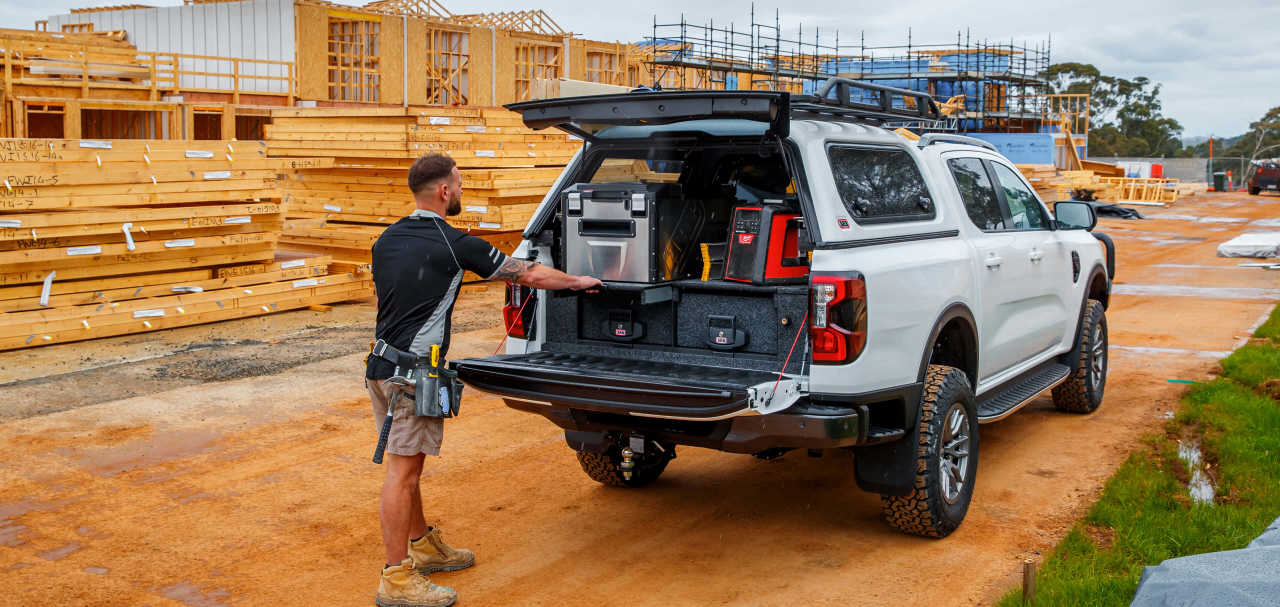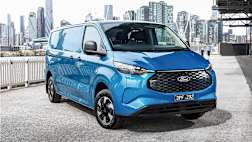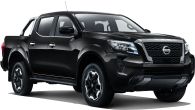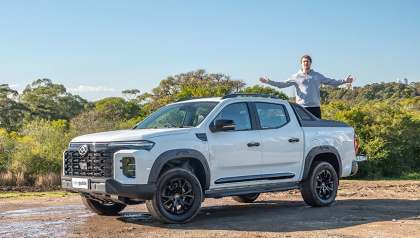Never has the dual-cab ute market been such a noisy place. The established favourites are still doing huge business and the newcomers are arriving thick and fast, mainly from China, but all jockeying for some clear space and the chance to claim their share of willing customers.
Against that backdrop, GWM’s Cannon ute – a vehicle that was launched here back in 2021 – has been selling into this super-heated market and claiming around 750 sales per month for a roughly 4.5 per cent share of the four-wheel-drive ute market. Okay, so it isn’t about to give the Ford Ranger, Toyota HiLux or Isuzu D-Max a scare, but those are worthwhile volumes and have given GWM the impetus to now make the product even better.
The focus has swung around to private buyers, too, as GWM realises that this is where the pragmatic money lives, and where value for money perhaps ranks higher on the list of priorities.
-
Is Australia ready for plug-in hybrid utes and off-roaders? The answer could make or break this brand's 2025 plans | Analysis
-
Cut-price ute gets crucial grunt and towing boost: 2025 GWM Cannon pricing released for affordable Ford Ranger, Toyota HiLux, Isuzu D-Max and Mitsubishi Triton rival
-
Popular medium SUV updated: 2025 GWM Haval H6 GT range tweaked as brand awaits incoming plug-in hybrid variant to rival BYD Sealion 6 and Mitsubishi Outlander PHEV
So what’s changed this time around? Mainly the driveline, interior and the vehicle’s appearance, arguably the areas that needed a bit of spit and polish in the first place. Oh, and the bigger engine now means it can now tow more.
Along the way, GWM has change the name - it used to be GWM Ute Cannon, but the 'Ute' has been dropped - simplified the model line-up, ditched the two-wheel-drive version and lost the alloy tray option. The entry-level Premium model has also taken a dive… for now. Expect to see it back on the price lists soon as new entree into the Cannon, er, canon.
GWM Cannon 2025: Lux (4X4)
| Engine Type | Diesel Turbo 4, 2.4L |
|---|---|
| Fuel Type | Diesel |
| Fuel Efficiency | 8.4L/100km (combined) |
| Seating | 5 |
| Price From | $40,490 |
Price and features – Does it represent good value for the price? What features does it come with?
8 / 10
GWM’s pricing for the Cannon was already pretty sharp, and when it took the axe to its price list late last year, the most basic Cannon became a $35,490 drive-away proposition. An obvious move to clear stock that would soon have the wrong year on its build-plate, the policy sure created some interest in the Cannon range as a whole.
Value for money is a major selling point with a vehicle like this, so how does the upgraded Cannon stand up? Pretty darn well, actually, and with a starting price of $40,490 you can forget about a stripped out specification or, indeed, having to pay more for a dual-cab layout or all-wheel drive.
Inside, you’ll find single-zone climate-control (with rear outlets), a wireless phone charger, power windows, the new 12.3 inch touchscreen, digital radio, voice command and artificial leather trim (seats and steering wheel), Apple CarPlay and Android Auto (which paired with my often recalcitrant phone seamlessly).
.jpg)
Eighteen-inch alloy wheels are standard, along with a chrome sports bar, auto LED headlights, auto high-beam, LED indicators and tail-lights, roof rails, power-folding exterior mirrors, side steps, damped tailgate, keyless entry and a spray-in bedliner.
The Ultra – and the version we’ve actually driven here - is next at $43,490 and adds leather-accented seats which are also heated and ventilated, a heated steering wheel, auto power windows, a six-way electrically adjustable driver’s seat (four-way for the passenger) ambient interior lighting and a light in the front footwells. Tinted rear windows are another Ultra addition, as is a tailgate step and, crucially, an electric sunroof.
Next step up is the Vanta at $45,490 which is fundamentally an Ultra with extra black bits. It’s identified by blacked-out alloy wheels, as well as a black sports bar, black side steps, and matt black wheel arches, exterior mirrors and door handles.
GWM tells us that the Ultra and Vanta are likely to be the big volume sellers.
The flagship Cannon is the XSR and $49,990 buys you a different grille, snorkel, stronger side-steps better able to tackle rocky tracks, and body-coloured mirrors and door handles. But a fair bit of the extra asking price goes towards an alternative driveline which we’ll cover in the under the bonnet section.
What’s missing? The lack of dual-zone air-con on any of the upper-spec models seems a bit strange, and a head-up display would be welcome.
Design – Is there anything interesting about its design?
7 / 10
As mid-cycle refreshes (read: facelifts) go, this is a biggie. Even the way the company refers to its product has changed and what was the GWM Ute is now officially the GWM Cannon. Beyond the semantics, the facelifted Cannon is slightly bigger, has a new look inside and out, gets more performance and towing capacity.
The size increase amounts to an extra 6mm in length and 13mm in width, but GWM admits that’s all in the bumpers and the fender flares. If anything, the overall look is a bit more subtle, with a new bonnet, grille, fog lights, flares and a new tailgate with the GWM logo embossed into it. Even so, there’s a still a suspicion that GWM doesn’t mind if folks look at the Cannon and imagine a full-sized American pick-up.
Inside, the trend of twin screens continues, this time with a pair of same-size 12.3-inch screens; one for the driver’s information and a central one for everything else. A rectangular theme makes up the dashboard’s elements including the basic structure and even the shape of the air vents.
Getting the vehicle to handle ever increasing payloads and towing limits has called for constant revisions in cooling systems, suspension and, most recently, the vehicle’s body-on-chassis structure to improve capacity while still meeting in-house and engineering requirements.
Practicality – How practical is its space and tech inside?
7 / 10
Having twin screens of the same size in the cabin makes for a techy look, but in reality, the centre screen is less than perfect. That’s because it’s clearly made for a left-hand-drive car and some of the menu items are w-a-y over to the left, out of reach for a driver of normal stature. The script is also pretty small in places, and those who wear reading glasses might find it all a bit indecipherable, especially on the move.
That Top-Gun T-bar shifter is also a bit confusing at first thanks to the Park button placement, but it’s also a bit baffling when you can’t work out how to select gears manually even though you’ve shifted into M (Manual) mode. There just doesn’t seem to be any way to get the shifter to, er, shift. And that’s because it doesn’t. Instead, you use the shifter to select Manual mode and then use the paddle shifters on the steering wheel to actually change the gears.
_0.jpg)
The front centre console is home to a single USB-A and USB-C charging port as well as a 12-volt outlet, and there are plenty of storage cubbies around the cabin. The interior plastics on the Ultra, meanwhile, actually feel better than they look. The door cappings, especially, look a bit hard and brittle but are actually quite compliant to the touch. Our other observation would be that the standard sunroof opening is actually quite small and there seems to be lots of buffeting from it at speed.
The rear seat is better than some dual-cabs by having a more rational back-rest angle, and there’s lots of foot-room under the front chairs. There’s also plenty of head-room in the back, mainly because the roof lining dips up at the point the sunroof stops (perhaps explaining the small sunroof opening). Rear seat passengers will also appreciate the pair of charging ports, central air vents and the fold-down armrest.
The tray of the Cannon is competitively sized (and, crucially, will accept a standard pallet between the wheel arches) but the spray-on bedliner looks a bit half-finished at its edges; almost as if the masking process before spraying was rushed. Still, the sprayed-on surface itself is grippy and feels like it would be fairly durable. Our biggest complain would be a lack of tie-down points. There are two up front which are too high to be really useful, and two in the rear corners. The problem there is that heavy loads which need the lower tie-downs would ideally be placed farther forward in the tray, not right at the back.
There’s some nice thinking with the damped tailgate, though, and the bonnet also lifts on gas struts which is a bit of a novelty on this type of vehicle. The fold-out tailgate step is another neat touch and is easy to use, even if it’s still a decent step up to get a foot squarely on it. And the sports bar? About as useful as anybody else’s version of the same thing. Which is to say, not very.
The new, bigger engine has enabled GWM to bump the Cannon’s towing maximum to a competitive 3500kg with a braked trailer. All variants apart form the XSR also have a 995kg payload which is also among the better figures in this class of vehicle.
Under the bonnet – What are the key stats for its motor?
7 / 10
The engine bay is the scene of perhaps the biggest improvements GWM has made to this vehicle. While the previous version’s eight-speed automatic was good enough, there was a feeling out there that the 2.0-litre turbocharged engine with its 120kW and 400Nm was seen as a bit marginal when fully loaded or hitched up to a decent-sized trailer.
So, the new 2.4-litre four-cylinder turbo-diesel (lifted from the Cannon’s Alpha big brother) makes for 15kW extra (135kW) and a meaningful 80Nm boost to take torque to 480Nm. The eight-speed automatic is now a nine-speed unit.
The basic four-wheel-drive system of the Cannon is a permanent one which constantly drives all four wheels. (Unless, that is, you engage the Eco drive mode which disconnects the front axle to save fuel). The dual-range transfer-case gives low-range ratios for off-roading and there are multiple drive modes including Standard, Sport and Eco. An electronic rear differential lock is also standard.
.jpg)
But the flagship makes the move to a part-time all-wheel-drive set-up which, to some may seem like a backward step as it removes the option to use high-range four-wheel-drive on the bitumen, which is a huge plus when towing on a damp road, for instance. Instead, the XSR can select two or four-wheel drive as well as the same choice of high or low range.
Fundamentally, unless you’re on a slippery, off-road surface, the XSR must stay in rear-wheel-drive only. But you do what GWM calls All Terrain Response which includes Mud, Snow and Sand modes, as well as an extra drive called Expert, which allows the driver to tailor various responses. The off-road orientation of the XSR model also dictates a front differential lock.
Front suspension on all Cannons is independent by coil springs, while the solid rear axle is suspended by leaf springs.
Efficiency – What is its driving range?
7 / 10
Get this: Despite more power and torque, the official combined fuel economy figure has fallen a whole litre from 9.4 litres per 100km for the old car to 8.4 litres for the new version. That also means lower tailpipe emissions.
Speaking of which, the engine in the Cannon is Euro 5 compliant (rather than Euro 6) so it doesn’t require AdBlue. Taking into account the 78-litre fuel tank and the real-world fuel consumption figure of 10 litres per 100km, bank on a theoretical range of around 750km before you need to find a service station.
.jpg)
Driving – What's it like to drive?
6 / 10
On the road, it doesn’t take long to appreciate the benefits of the new, torquier engine. Although there’s a little diesel clatter at idle and a slightly gruff soundtrack beyond that, it all soon smooths out above about 1200rpm. From there, it’s quite a rush as the engine is clearly tuned for bottom-end torque rather than top-end rush and, in this type of vehicle, that makes perfect sense.
If anything, the nine-speed transmission seems a little hesitant to set sail until there’s some boost for the taking, and this can feel a bit weird when you’re trying to merge into freeway traffic or jump into a space in traffic. The gearbox also reveals itself to be a bit too keen to hold on to the current gear when your throttle position and speed suggest a shift up would be logical. That said, when it does upshift, the shift quality is extremely good with a crispness that means the multiple gears never seem an overwhelming number.
.jpg)
The ride only starts to get rowdy on faster, really bumpy sections where the leaf-spring rear axle starts to run out of reaction time, but below that threshold, the Cannon rides remarkably sanely and corners relatively flatly into the bargain.
Our main gripe is with the steering, but only in terms of the driver-assistance dumbing down of the whole experience. With the lane-keeping assistance switched off, the steering reveals itself to be fairly neutral with a slight dead-spot at the straight-ahead (normal enough for off-road vehicles). But with lane-keeping active, the Cannon’s constant corrections and nudging at the tiller will drive you mad. It’s too sensitive, too aggressive and too insistent, and we suspect GWM knows it.
.jpg)
Certainly, the brand professes to be constantly refining these assistance packages but it’s also fair to say that some carmakers simply have a better grasp of this tech.
Off road, the Cannon is a pretty sure bet to take you anywhere 99 per cent of the population will want to go 99 per cent of the time. The limiting factor here will be the tyres, and with a pretty non-aggressive tread pattern on the standard hoops, the first thing most adventurous owners will do will be to fit a set of All Terrains and tick that box for that last one per cent of ability.
.jpg)
Warranty & Safety Rating
Safety – What safety equipment is fitted? What is its safety rating?
7 / 10
Now, here’s an odd situation. Normally, paying more for a higher-grade model means getting more of everything including safety. In the new Cannon, that isn't necessarily so. But we’ll get to that.
Meantime, the cheaper versions of the Cannon are fairly bristling with modern safety gear, starting with the centre airbag that so many manufacturers are still waiting to fit. That takes the airbag total to seven with side-curtain airbags for every outboard passenger.
There’s also a reversing camera, rear parking sensors, adaptive cruise control, trailer-sway mitigation, hill ascent and descent, traffic sign recognition, rear collision warning and a driver-fatigue monitoring system.
The entry-level Cannon (and the next two grades) also get the latest driver assistance aids, too, starting with autonomous emergency braking (AEB), blind-spot monitoring, traffic-jam assist, lane-keeping assistance, rear cross-traffic warning and braking and junction-assist braking. There’s also a program called 'smart dodge' which moves the car away from vehicles changing lanes on top of it. It’s also worth mentioning that the AEB works at all speeds and is capable of recognising both pedestrians and cyclists.
_0.jpg)
Both the Ultra and Vanta include a 360-degree camera rather than the simpler reverse camera of the Lux, an auto-dimming interior mirror and front parking sensors.
So what about the XSR, then. Well, according to GWM, the layout of the XSR precludes the fitment of some driver aid technology. So it LOSES emergency lane keeping, rear collision warning, blind-spot detection, lane-change assist, smart dodge, and rear cross-traffic alert and braking.
So come on GWM, what’s that about? Apparently, it’s all to do with the shape of the rear bumper of the XSR which is designed to offer improved departure angles when off-road. Okay, but that doesn’t change that you’re paying more for less. And when that less is safety, that’s really hard to fathom.
This version of the Cannon hasn’t been ANCAP tested, but the previous model has, and scored the full five stars. GWM, meanwhile, isn’t obliged to re-test this version, and has no plans to do so, confident instead that the previous model’s results and the documentation it has provided will convince the test authorities to extend those five stars to this car.
_0.jpg)
Ownership – What warranty is offered? What are its service intervals? What are its running costs?
8 / 10
The Cannon ute comes with GWM’s standard factory warranty of seven years/unlimited kilometres. That’s not quite industry-leading any longer, but it’s still a heck of a lot of peace of mind. You also get five years of roadside assistance that applies anywhere in Australia.
GWM also offers capped-price servicing for the first five years with major and minor services included. There’s no word on the cost of that yet, but GWM told CarsGuide that the price would not be dramatically different from the previous model’s capped-price scheduled maintenance. That suggests somewhere around the $360 per service mark.
There’s a first service due at six months or 5000km, and then regular services every 12 months or 10,000km after that.
Verdict
It’s often said the poor man pays twice, and there’s no doubt that some budget cars are destined to be throwaways once the warranty period expires (which doesn’t explain paper drinking straws). The GWM Cannon doesn’t give off that vibe. Rather, it stands out as a way to get nearly all of the experience of a similar vehicle costing $20,000 or even $30,000 more.
We’d like dual-zone climate-control, a shifter that shifts manually, and the driver assistance programs need polish. But the fundamentals are there and its fair to say the Cannon has never been a bigger threat to the dual-cab establishment.
The specification of the flagship model seems odd to us, but this car, the Ultra is destined to be the volume seller anyway and, viewed through that prism, along with the improved performance and towing, the whole Cannon ute thing starts to gel.
Note: CarsGuide attended this event as a guest of the manufacturer, with meals provided.
Pricing Guides

Range and Specs
| Vehicle | Specs | Price* |
|---|---|---|
| Lux (4X4) | 2.4L, Diesel, 9 SPEED AUTOMATIC | $40,490 |
| Premium (4X4) | 2.0L, Diesel, 8 SPEED AUTOMATIC | $37,490 |
| Ultra (4X4) | 2.4L, Diesel, 9 SPEED AUTOMATIC | $43,490 |








.jpg)
.jpg)
.jpg)
.jpg)
.jpg)
.jpg)
.jpg)
.jpg)
.jpg)
.jpg)
.jpg)
.jpg)
.jpg)
.jpg)
.jpg)
.jpg)
.jpg)
.jpg)
.jpg)
.jpg)
.jpg)
.jpg)
.jpg)
.jpg)
.jpg)
.jpg)
.jpg)
.jpg)
.jpg)
.jpg)
.jpg)
.jpg)
.jpg)
.jpg)
.jpg)
.jpg)
.jpg)
.jpg)
.jpg)
.jpg)
.jpg)
.jpg)
.jpg)
.jpg)
.jpg)
.jpg)
.jpg)
.jpg)
.jpg)
.jpg)
.jpg)
.jpg)

_0.jpg)
_0.jpg)
_0.jpg)
_0.jpg)
_0.jpg)
_0.jpg)
.jpg)
_0.jpg)
_0.jpg)
.jpg)
_0.jpg)
_0.jpg)





.png)

.png)






.jpg)
